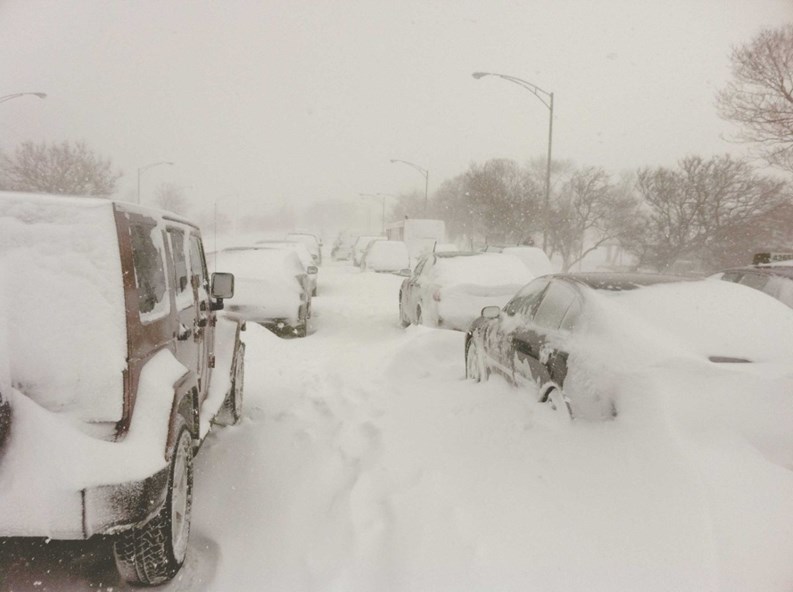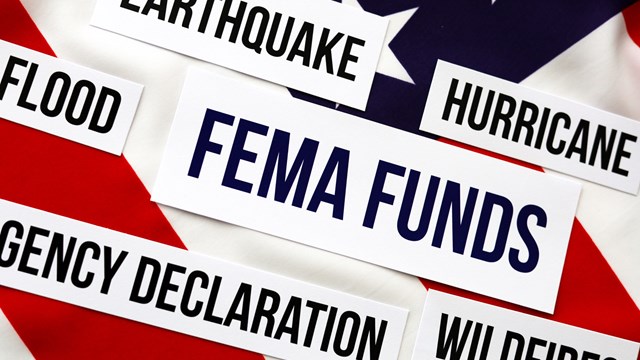Chicagoans pride themselves on the ability to withstand bitter winters but sometimes Mother Nature just does get the better of us. For proof, just look at the pictures from this past January of abandoned cars along Lake Shore Drive and it is eerily reminiscent of a post-apocalyptic world. The massive blanket of snow paralyzed the region but the after-effects of the blizzard wreaked havoc on buildings throughout Chicagoland. Once again, many buildings were unprepared for Jack Frost's wrath, and the lack of preparation caused a lot of chaos. So how does one prepare for the worst?
Jim Stoller, the president of The Building Group, a building management company in Chicago, believes that preparation is key, “I'm a former Boy Scout, and our motto was 'be prepared.' An association must have a plan in place, it doesn’t matter what the emergency is—blizzard, fire, electrical outage, blackout, plumbing, you have to have a plan in place for everything,” he says. “Nobody wants to think about any of these emergency situations and their aftermath, but it’s better to talk about it and know what you’re going to do before an emergency—without a plan, people panic, and that can make things worse.”
The Most Common Emergencies
The most common emergencies are severe weather, blackouts, gas leaks, sickness, and fire, but you should plan for anything such as bedbugs or even the pandemic flu. Believe it or not, planning for a natural disaster such as a hurricane is actually a little easier because such events provide at least a little warning.
“We are constantly checking weather reports,” says Stoller, “This past winter we were completely prepared for the blizzards. Our employees knew what they were supposed to do and we had the tools and resources available so the weather did not effect our unit owners badly at all,” he said.
“The management company and the Board of Directors should work together to prepare a flexible disaster management plan for their community,” advises Gina Rossi, the manager of marketing and sales for Associa, a company specializing in community association management headquartered in Chicago. “The best prevention is to know your environment, the risks of the area, and then prepare for the worst.” Rossi adds, “Associations that are prepared can reduce the inconvenience, losses and fears that encompass disasters.”
“The three main areas to focus on are the 3 R’s, response, recovery and restoration,” Rossi says. “Employees should be trained to be responsive in emergency situations. Frequent drills for fire, tornadoes, earthquakes, hurricanes, wild fires and bomb threats will help instill the process.”
“The most important part of any plan is communication,” says Stoller. “You have to have something in place so everyone knows what they are supposed to do and who they are supposed to call. I can't emphasize this enough, communication is key. It is so important for unit owners to contact building management to let them know if something is broken, even if the unit owner doesn't think it's that important, they should contact management so it can be fixed. Not communicating a small problem could cause that small problem to become a major problem down the line.”
Last year a fire occurred in one of the buildings that Stoller's company managed. He recounts, “The fire started at 11:00 and was out by 1:00. By the time the fire was out our emergency response team was on-site already working to help the homeowners. The fire department said that it would probably take a couple of days before any of the homeowners, whose units were not directly affected by the fire, would be able to return home. But because we had a plan, and everyone on the emergency response team knew what they were doing, our homeowners were able to return after just one day. The fire department was extremely impressed by our planning and organization.”
Have a Plan in Place
Stoller notes, “We had just taken over management of this particular building ten days before the fire, but because we had a good plan, and well-trained employees we were able to deal with this emergency quickly, efficiently and safely.”
Although an emergency can strike any building at any time, the reality is that an emergency plan is a not a one-size fits all solution. “While some of the buildings can get a standard emergency plan, it really should be tailored to each building and its size and needs to be specific,” Rossi says.
The good news, say the experts, is that a simple straightforward, checklist plan may be more than enough in most cases. This type of “all-hazard” planning is the most efficient solution for dealing with disaster, according to officials from the Federal Emergency Management Agency (FEMA).
“We always push the all-hazards plan,” explains FEMA’s Rob Pesapane, “but it's important to know the hazards in your area. For instance, if your condo association is in a flood zone, you should have some kind of understanding of preparedness issues and dealing with floods. But the plan should be flexible, because you never know what emergency may occur.”
Buildings, no matter what size require a specific plan, Rossi says. Most buildings can be proactive by having a disaster plan in place. She notes that the key components of the plan should include and are not limited to:
• Having a Risk Assessment/ Disaster Reduction plan, examples of which would include: 1) Forming a team and developing a mission statement and disaster plan. 2) Training personnel in all aspects of this plan and clearly defining authority and a chain of command while also maintaining records of all homeowners’ contact information. 3) Addressing emergency, post emergency and complex emergency situations. Establishing a location for disaster control operations pre- and post-emergency. 4) Putting a mitigation program in place. (Examples of which are backing up all computer software and files, powering down all appliances/electronics, securing and/or storing non-permanent structures or equipment. Shutting down all systems, such as irrigation and pool. Removing or securing any objects that can become detached and cause additional damage like awnings. 5) Monitoring the news for information on any storms, or other public emergencies that could be a possible threat to communities. This would include distributing the plan to all homeowners and posting this information on the community website; ensuring owners are familiar with the evacuation plan and evacuation map and procedures; posting emergency contact telephone numbers in buildings, hallways, elevators and clubhouse; and notifying the contractors and staffing of the potential dangers and activating emergency procedures.
Above all Rossi suggests that, as she previously pointed out that the “Three R's” be followed—Relief, Recover, Rebuild. This means: Relieve the homeowners by stabilizing the situation and addressing any assistance for the homeowners like access to supplies and information. Recover, by determining the level of the disaster and providing sanitation and shelter. And Rebuild, by coordinating the response team and other persons responsible for disaster relief and recovery.
According to Stephen R. Barber, CPM author of Community Associations, a Guide to Successful Management, published by the Institute of Real Estate Management (IREM), your plan should include knowledge of fire alarm systems, the ability to operate emergency generators, and access to lifesaving equipment, storm warnings, and emergency procedures with detailed plans for evacuation facilitate the ability to handle a serious situation properly.
“The most important things that should be addressed are that all residents should be aware of the closest egress points available to them,” according to Linda G. Nelson, who is the director of the New York-based Thomas Shortman Training, Scholarship and Safety Fund of SEIU-32BJ, the building service workers' union. With more than 120,000 members in eight states and Washington, DC, 32BJ is the largest property service workers union in the country. In Chicagoland, SEIU Local 1 represents building workers in Illinois, Indiana, Michigan, Missouri, Ohio, Wisconsin and Texas.
“They should be alerted to avoid elevators for most emergencies and a list of those residents or tenants requiring special attention should be available at the security/concierge desk,” Nelson continues. “Staff or resident helpers should be assigned in advance to certain areas to ensure smooth evacuations. Residents and staff should also be taught how to 'shelter–in–place' or take shelter on site in case the emergency is outside the building.”
Nelson also explains that if management is struggling with starting the safety talk or putting together a plan, the Chicago Metropolitan Police will send someone to your building to discuss security and safety concerns and make recommendations. Chicago-based SEIU Local 1 also offers a series of safety and security and building evacuation training classes to its building service workers.
Understanding the Message
Communication is key in even the most day-to-day building business, but in an emergency, being able to understand and be understood can become a matter of life and death. At some point, you may need to evacuate the building. And although each resident is truly responsible for her own evacuation, managers and staff should be the guiding force to make sure it goes smoothly. Your residents are going to want to know what’s going on and where they should go. Stoller knows that if the building needs to evacuate, his team knows how to do it. “Our employees would go floor by floor to make sure all the residents are out,” he says.
Stoller suggests practicing this evacuation plan regularly with your residents and your staff and make sure your escape plan is labeled and have a backup plan in case your first option is blocked. If there is an emergency, make sure you stay calm and contact your local authorities immediately, and in the proper order. Stoller says that the first thing his building managers do is to call 911 first, and then the management company office.
An Ounce of Prevention
Benjamin Franklin might have had it right when he said that an ounce of prevention is worth a pound of cure. A good emergency plan doesn’t just address the emergency, but also has tips to prevent the emergency from occurring. Have your residents prepared for an emergency by maintaining “go bags” so that they can grab and run. All residential tenants and unit owners should also have an emergency kit, which includes drinking water, flashlights, fresh batteries, a water-resistant battery operated AM-FM radio and a Mylar emergency blanket. They should also have an evacuation kit that includes medical supplies, flashlights, batteries, first aid kit, and change of clothes, important phone numbers, car keys and house keys.
Another preventative tip is to make sure that your entire building is up to code and your emergency equipment, sprinklers and fire extinguishers for example, are in working order. Sprinkler systems and fire extinguishers save lives. If you have a building communication system, test it regularly to make sure it reaches all of the residential community. Check all smoke and heat detectors and any automated external defibrillators (machines that restore heart rhythm). Make sure your emergency lighting is always working as well.
The Boy Scout motto of “Be Prepared,” rings true in any situation. It’s a team effort with you, your staff and residents doing their respective jobs and staying safe.
Keith Loria is a freelance writer and a frequent contributor to The Chicagoland Cooperator. Associate Editor Liam P. Cusack contributed to this article.







Leave a Comment